Asian Americans are the fastest-growing major racial or ethnic group in the United States. More than 20 million Asians live in the U.S., and almost all trace their roots to at least 19 countries in East and Southeast Asia and the Indian subcontinent, according to a Pew Research Center analysis of U.S. Census Bureau data.
The 19 largest Asian origin groups in the U.S. differ significantly by income, education and other characteristics. These differences highlight the wide diversity of the nation’s Asian population and provide a counterpoint to the “model minority” myth and the description of the group as monolithic. Highlighting these differences within the Asian population has been central to debates about how data about the group should be collected by governments, colleges and universities and other groups, and how it can be used to shape policies impacting the diverse U.S. Asian population.
Here’s a look at some of these differences, as well as how individual origin groups compare with the nation’s overall Asian American population.
This analysis and the accompanying fact sheets about the Asian population in the United States combines the latest data available from multiple data sources. The main source used is a three-year dataset constructed from the U.S. Census Bureau’s 2017-2019 American Community Survey’s public-use files obtained from the Integrated Public Use Microdata Series (IPUMS). The ACS is used to present demographic and economic characteristics for each group. Additional data on population estimates were obtained from the Census Bureau’s 2012 report, “The Asian Population: 2010” (2000 and 2010) and tables available through Census Data. Population projection figures are from the Census Bureau’s 2017 population projections.
Population estimates for all Asian groups include mixed-race and mixed-Asian group populations, regardless of Hispanic origin. As a result, there is some overlap in the numbers for the individual Asian groups because people with origins in more than one group are counted in each group to which they belong. For example, an individual identifying as “Chinese and Filipino” would be included in the totals for all Chinese and all Filipinos.
All data was collected before the COVID-19 pandemic.
Six origin groups – Chinese, Indian, Filipino, Vietnamese, Korean and Japanese – accounted for 85% of all Asian Americans as of 2019. These groups together largely shape the demographic characteristics of the overall U.S. Asian population.
Chinese-origin Asians are the largest single Asian origin group in the U.S., making up 23% of the total, or 5.4 million people. The next two largest origin groups are Indian Americans, who account for 20% of the total (or 4.6 million people), and Filipinos, who account for 18% (or 4.2 million people). Those with roots in Vietnam (2.2 million), Korea (1.9 million) and Japan (1.5 million) each have populations of at least 1 million.
The other 13 Asian origin groups in this analysis each make up about 2% or less of the nation’s Asian population. Demographically, these groups often differ greatly from the largest groups.
Population growth varied across Asian origin groups between 2000 and 2019. Eleven of the 19 groups more than doubled in size during this span. Some of the smaller origin groups – such as Bhutanese, Nepalese and Burmese – experienced the fastest growth rates, with their populations growing tenfold or more between 2000 and 2019. Laotians and Japanese have had the slowest growth rates among U.S. Asians since 2000.
Which Asian origin group is largest varies by state. In 22 states that are largely concentrated in the Southeast and Midwest, Indian Americans are the largest Asian origin group. Chinese are the largest group in the District of Columbia and 12 states – predominantly in the West and Northeast – while Filipinos are the largest origin group in nine states. Vietnamese Americans are the largest Asian origin group by population in four states (Louisiana, Mississippi, Oklahoma and Nebraska); Hmong Americans are the largest in Minnesota and Wisconsin; and Korean Americans are the largest in Alabama.
The population concentrations of Asian Americans in each state reflect each origin group’s migration patterns over time. Many Indians, for example, have recently migrated to the U.S. on work visas and student visas. Many Chinese Americans have taken those paths, too, but the Chinese population also has a long history in Western states, arriving in California as early as the 19th century. Hmong Americans, meanwhile, entered the U.S. starting in the late 20th century as refugees, with most resettling in Minnesota.
A third of Japanese Americans are multiracial (non-Hispanic), by far the highest share among the six largest Asian origin groups. Filipinos are the next most likely to indicate their race is Asian and at least one other race, with 19% doing so. Nearly one-in-seven Koreans (15%) say they are multiracial, as do 8% of Chinese. Out of the six largest origin groups, Vietnamese (5%) and Indians (4%) are the least likely to indicate their race is Asian and at least one other race.(The Census Bureau only publishes multiple-race combination data for the six largest Asian American groups.)
Hmong, Burmese and Nepalese Americans are the youngest Asian origin groups in the U.S., while Thai and Japanese Americans are the oldest. The median age for Hmong, Burmese and Nepalese in 2019 was 30 or younger. Among U.S.-born Burmese and Nepalese, the median age was even younger – just 6 and 5, respectively.
Thai and Japanese Americans, by contrast, had a median age of 41 in 2019. U.S.-born Japanese were the oldest by far among all Asians born in the country, with a median age of 36. Thai Americans were the second-oldest U.S.-born group, with a median age of 25.
The overall Asian population in the U.S. had a median age of 34 in 2019, including 19 for U.S.-born Asians and 45 for those born outside the U.S.
The share of Asian Americans ages 25 and older with at least a bachelor’s degree varies greatly by origin group. Those of Indian (75%), Malaysian (65%), Mongolian (60%) or Sri Lankan (60%) origin are more likely than other Asian origin groups to have at least a bachelor’s degree. By comparison, fewer than one-in-five Laotians (18%) and Bhutanese (15%) have at least a bachelor’s degree. Roughly a third of all Americans ages 25 and older had a bachelor’s degree or more education in 2019.
The differences in educational attainment among national origin groups partly reflect the levels of education immigrants bring to the U.S. For example, three-quarters of Indian Americans had a bachelor’s degree or more education in 2019. Many of them already had a bachelor’s degree when they arrived in the U.S. with visas for high-skilled workers. Since 2001, half of H-1B visas – which require a bachelor’s degree or equivalent – have gone to Indians.
English proficiency varies considerably among Asian origin groups. Among those ages 5 and older, large majorities of Japanese (85%), Filipinos (84%) and Indians (82%) speak English proficiently. By contrast, Bhutanese (36%) and Burmese (38%) – both groups with large populations of recently arrived immigrants – have some of the lowest rates of English proficiency. U.S.-born Asians (95%) are much more likely than foreign-born Asians (57%) to speak English proficiently.
There are wide disparities in income among Asian origin groups. Asian households in the U.S. had a median annual income of $85,800 in 2019, higher than the $61,800 among all U.S. households. But only two Asian origin groups had household incomes that exceeded the median for Asian Americans overall: Indians ($119,000) and Filipinos ($90,400). Most of the other origin groups were well below the national median for Asian Americans, including the two with the lowest median household incomes – Burmese ($44,400) and Nepalese ($55,000).
As with education and income, poverty rates vary widely among Asians in the U.S. Asians Americans had a poverty rate of 10% in 2019, 3 percentage points lower than the overall U.S. poverty rate (13%). Mongolian and Burmese had the highest poverty rates among all Asian origin groups, at 25% – more than twice the national average and about four times the poverty rates among Indians (6%).
Around a quarter of Asian Americans (27%) live in multigenerational households, but some origin groups are far more likely than others to do so. Multigenerational households include two or more adult generations or both grandparents and grandchildren. More than half of Bhutanese (56%) and a large percentage of Cambodians (42%) and Laotians (40%) live in multigenerational households. On the other hand, only 16% of Malaysians and 13% of Mongolians live in multigenerational households. Among Americans overall, 20% live in multigenerational households.
Vietnamese Americans have the highest homeownership rate among Asian Americans (67%). That is comparable to the homeownership rate among all Americans (64%).Many other Asian American origin groups havelower homeownership rates.For example, only a third of Nepalese Americans and fewer than half of Bangladeshi (45%) and Burmese Americans (46%) owned their home in 2019.
Immigrants make up a higher share of some Asian origin groups than others. Among all Asians in the U.S., nearly six-in-ten (57%) were foreign born in 2019, significantly higher than the immigrant share among Americans overall (14%) and other racial and ethnic groups that same year.
Some Asian groups have arrived as immigrants more recently than others. For instance, 78% of Burmese in the U.S. are foreign born, and many of them arrived as refugees starting in 2007. About two-thirds (68%) of Burmese immigrants have been in the country for 10 years or less.
By contrast, the first Japanese immigrants came to the U.S. in the 19th century as plantation workers in what is now Hawaii. Fewer Japanese immigrants have arrived in the U.S. in recent years compared with other Asian origin groups. This history is reflected in the relatively low share of Japanese Americans who are immigrants (27%). Among Japanese immigrants, 63% have been in the country for more than 10 years.
Note: This is an update of a post originally published May 22, 2019.
Related content

"asia" - Google News
April 30, 2021 at 01:03AM
https://ift.tt/3vqzUcH
Asian Americans and their origins: Key facts - Pew Research Center
"asia" - Google News
https://ift.tt/2YpEquI
https://ift.tt/2WkdbyX
Bagikan Berita Ini
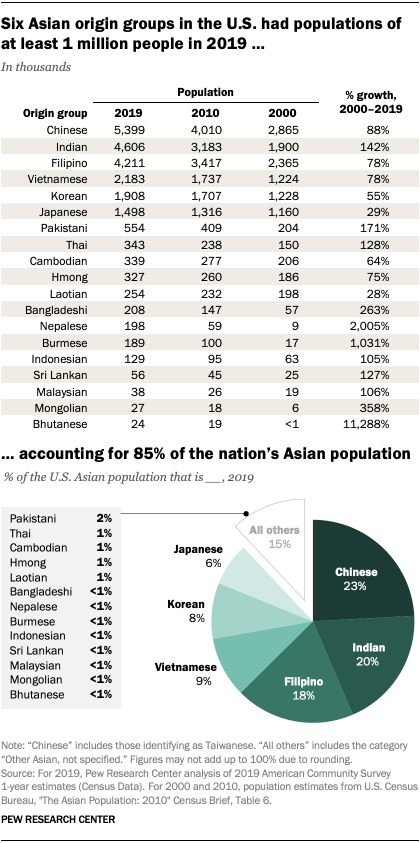
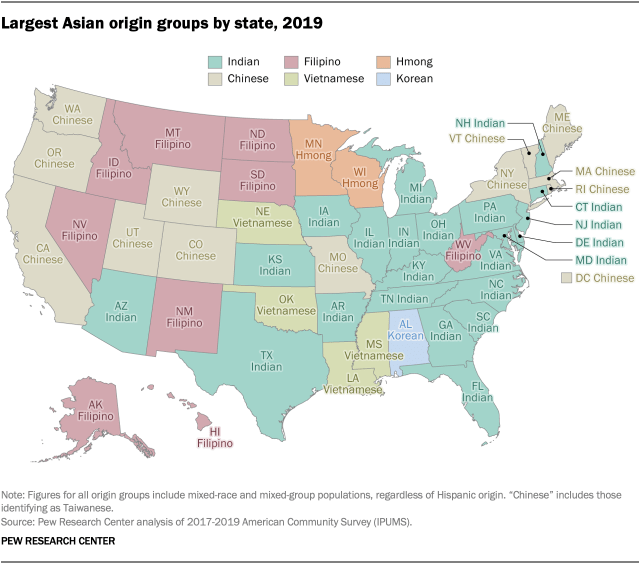
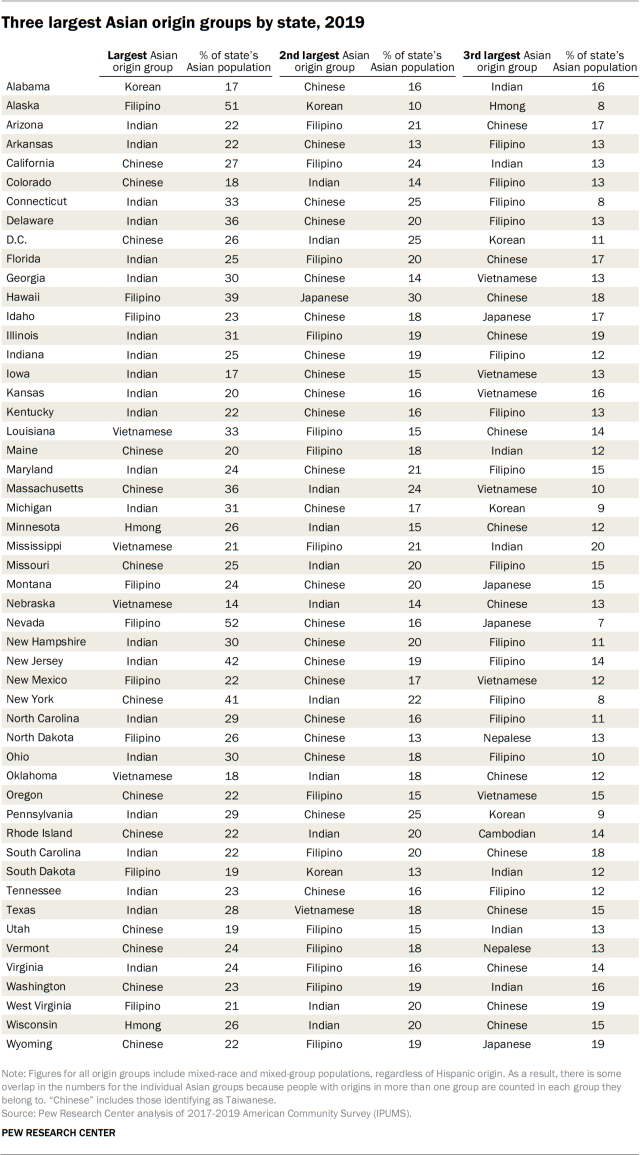
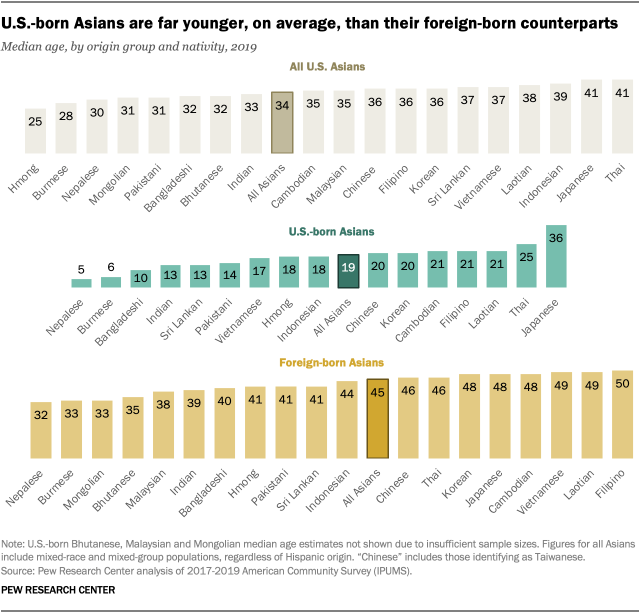

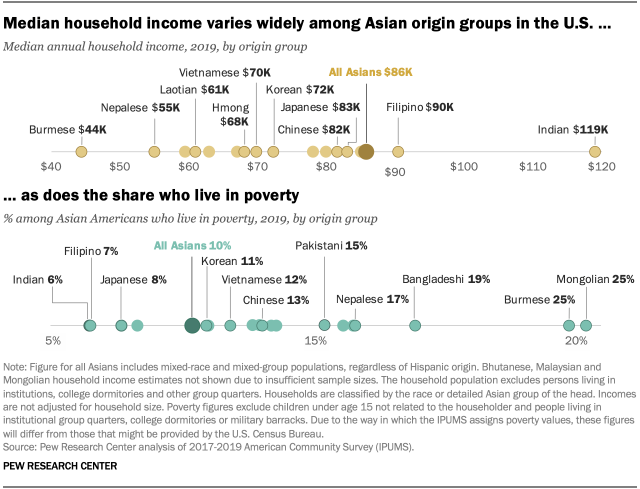
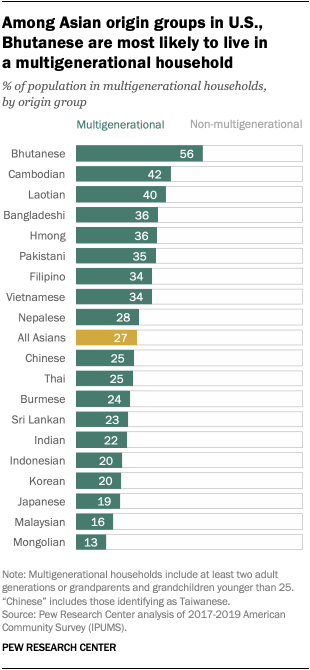
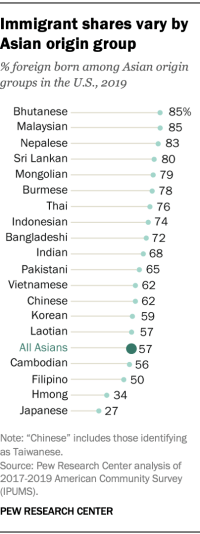














0 Response to "Asian Americans and their origins: Key facts - Pew Research Center"
Post a Comment